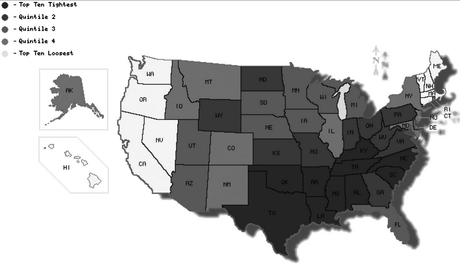Harrington and Gelfand offer a parsimonious mechanism for the striking cultural and political differences between the 50 United States by suggesting that the states differ in tightness (many strongly enforced rules and little tolerance for deviance) versus looseness (few strongly enforced rules and greater tolerance for deviance), with this being a logical outcome of their different circumstances (ecological threats, human threats, etc.). They find that tightness–looseness and collectivism–individualism are distinct constructs. Data from their index and state-level indices of collectivism–individualism demonstrate that there are tight states that are collectivistic (e.g., Alabama, Mississippi, Texas, South Carolina), loose states that are collectivistic (e.g., Hawaii, New Jersey, Maryland, California), loose states that are individualistic (e.g., Oregon, Washington, New Hampshire, Vermont), and tight states that are individualistic (e.g., Wyoming, Kansas, Oklahoma, Ohio).
In this tightness-looseness figure, the states are organized into quintiles, with the top ten loosest being the lightest color. The map (click to enlarge) was constructed at www.diymaps.net.

Here is their abstract:
This research demonstrates wide variation in tightness–looseness (the strength of punishment and degree of latitude/permissiveness) at the state level in the United States, as well as its association with a variety of ecological and historical factors, psychological characteristics, and state-level outcomes. Consistent with theory and past research, ecological and man-made threats—such as a higher incidence of natural disasters, greater disease prevalence, fewer natural resources, and greater degree of external threat—predicted increased tightness at the state level. Tightness is also associated with higher trait conscientiousness and lower trait openness, as well as a wide array of outcomes at the state level. Compared with loose states, tight states have higher levels of social stability, including lowered drug and alcohol use, lower rates of homelessness, and lower social disorganization. However, tight states also have higher incarceration rates, greater discrimination and inequality, lower creativity, and lower happiness relative to loose states. In all, tightness–looseness provides a parsimonious explanation of the wide variation we see across the 50 states of the United States of America.

